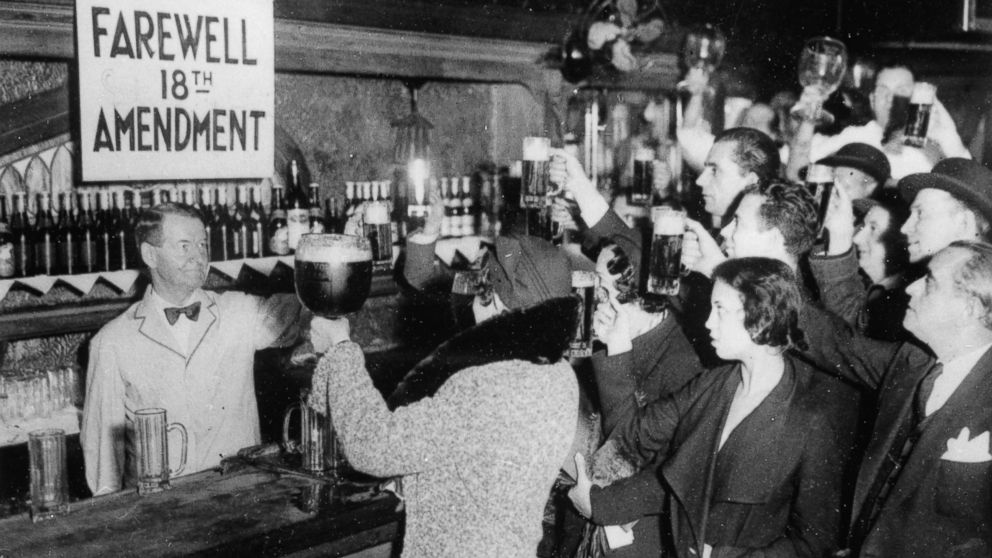Five Things You Don't Know About Alcohol
Learn secrets about eggnog, absinthe and nitrogen cocktails.

Dec. 5, 2013— -- intro: On Dec. 5, 1933, the United States ratified the 21st amendment to the U.S. Constitution, ending more than a decade of Prohibition. Federal law still bans the distilling of spirits in the home with numerous licensing requirements.
The law that banned alcohol sales throughout the nation went into effect Jan. 1, 1920, largely as a result of the Woman's Christian Temperance Union, which believed Prohibition would protect families from the dangers of alcohol abuse.
In the 80 years since, there are still concerns about its use, but here are several fun facts about alcohol and health you may not know.
ABC's Sydney Lupkin also contributed to this report.
quicklist: 1title: You Don't Hallucinate on Absinthe
text: Absinthe may make the heart grow fonder, but it does not cause hallucinations, epileptic attacks or madness.
The herbal liqueur absinthe rose to popularity as an alcoholic drink in late 19th century France, gaining increasing favor in the 1920s with artists and writers living in Paris, including Ernest Hemingway. It was banned in the United States in 1915 because of its reputation as a hallucinogenic drink. The so-called "green fairy" is made from the herb wormwood.
The modern distilled version of the drink contains too little thujone, the active ingredient in wormwood that reportedly caused psychedelic effects. What absinthe does do is make you drunk, very drunk. It's 68 percent alcohol, or 136 proof or higher.
Absinthe legalized in 2007 in the U.S.
media: 21111304
quicklist: 2title: Alcohol Kills the Salmonella in Egg Nog
text: Eating raw eggs is not recommended, but scientists at Rockefeller University in New York City say that when mixed with alcohol, they are safe.
For 60 years, these researchers have been serving up a recipe that includes raw eggs, cream, spices and alcohol. They say it's drinkable even after being refrigerated for six weeks.
Doctors say store-bought eggs are sanitary because they have been cleaned before packaging.
Later, they introduced salmonella into a batch of eggnog to see if it would survive the alcohol content. It didn't. After five days, the bacteria had disappeared and the cocktail was drinkable.
Stock up on eggs for safe holiday cheer.
media: 21111208
quicklist: 3title: Hot Toddies Really Do Work for Colds
text: Hot toddies, which traditionally contain whiskey, lemon and honey, can give cold and flu patients relief from their symptoms by dilating blood vessels and helping the mucus membranes.
The virus may remain untouched, but the alcohol effect will make you feel better. Just keep up the nonalcoholic fluids when drinking spiked remedies, say doctors, so that you don't get dehydrated.
media: 21111118
quicklist: 4title: Uncle Sam May Start Keeping Track of Booze Calories
text: The government may soon require manufacturers of alcohol, beer and wine to disclose calorie content and other nutritional information on bottles and cans.
In 2007, the U.S. Alcohol and Tobacco Tax and Trade Bureau proposed a labeling rule, but it's only optional now.
The low-calorie beer manufacturers are hoping implementation might boost sales with more weight-conscious Americans.More information gives consumers tools to make educated choices.
media: 21111701
quicklist: 5title: Bartenders Have Most Injuries in Hospitality Industry
text: Being a bartender can be perilous. It's a delicate balancing act between keeping the customer well lubricated and not injuring yourself or the cocktails in the process.
It is one of the most physically and psychologically challenging professions. Physical demands include bending up and down to lift bottles and getting glass cuts. Wrist injuries from shaking cocktails are also common. Keeping customers happy and the cocktails flowing until late at night can stress out bartenders.
Liquid nitrogen injuries serving trendy cocktails have also been reported.
A bartender's work is backbreaking.
media: 21112518




